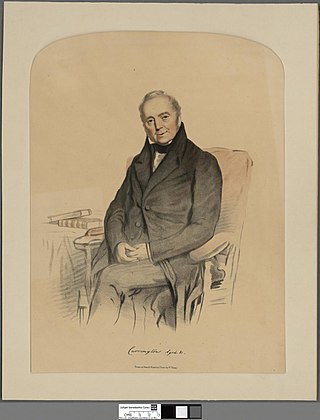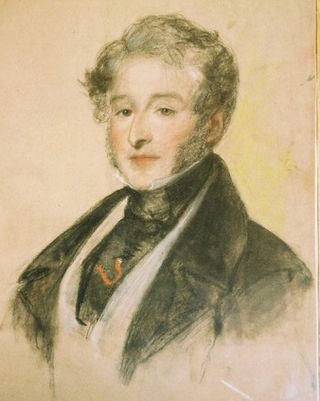Arms
  |
|
Baron Davies, of Llandinam in the County of Montgomery, is a title in the Peerage of the United Kingdom. It was created in 1932 for the Welsh businessman, Liberal Member of Parliament and philanthropist, David Davies. He was the grandson and namesake of the prominent industrialist David Davies Llandinam. [1]
The second Baron Davies was the son of the first Baron and his first wife, Amy, daughter of L. T. Penman. He married Ruth, daughter of Major William Marshall Dugdale, in 1939. They had two sons. Lord Davies fought in the Second World War as a major in the Royal Welch Fusiliers and was killed on the Western Front in September 1944, aged 29, only three months after succeeding his father in the barony. His three-year-old eldest son, David, inherited the barony shortly before his fourth birthday. [2]
As of 2024, the title is held by the fourth Baron, who succeded his father in that year. [1]
The heir presumptive is the current holder's brother, The Hon. Benjamin Michael Graham Davies (b. 1985)
  |
|
Marquess of Anglesey is a title in the Peerage of the United Kingdom. It was created in 1815 for Henry Paget, 2nd Earl of Uxbridge, a hero of the Battle of Waterloo, second in command to the Duke of Wellington. The Marquess holds the subsidiary titles of Earl of Uxbridge, in the County of Middlesex, in the Peerage of Great Britain (1784), Baron Paget, de Beaudesert, in the Peerage of England (1553), and is also an Irish Baronet, of Plas Newydd in the County of Anglesey and of Mount Bagenall in the County of Louth.
The title of Baron Grey of Codnor is a title in the peerage of England.

Baron Clinton is a title in the Peerage of England. Created in 1298 for Sir John de Clinton, it is the seventh-oldest barony in England.

Earl Cadogan is a title that has been created twice in the Peerage of Great Britain for the Cadogan family. The second creation, in 1800, was for Charles Cadogan, 3rd Baron Cadogan.

Baron Stafford, referring to the town of Stafford, is a title that has been created several times in the Peerage of England. In the 14th century, the barons of the first creation were made earls. Those of the fifth creation, in the 17th century, became first viscounts and then earls. Since 1913, the title has been held by the Fitzherbert family.

Baron Strange is a title which has been created four times in the Peerage of England. Two creations, one in 1295 and another in 1326, had only one holder each, upon whose deaths they became extinct. Two of the creations, that of 1299 and that of 1628, are extant. The surname Le Strange was Latinized as Extraneus. The arms of Le Strange of Knockin Castle in Shropshire were: Gules, two lions passant argent.

Earl of Craven, in the County of York, is a title that has been created twice, once in the Peerage of England and once in the Peerage of the United Kingdom.

Earl of Chichester is a title that has been created three times, twice in the Peerage of England and once in the Peerage of the United Kingdom. The current title was created in the Peerage of the United Kingdom in 1801 for Thomas Pelham, 2nd Baron Pelham of Stanmer.

Earl of Strafford is a title that has been created three times in English and British history.

Earl of Dudley, of Dudley Castle in the County of Stafford, is a title that has been created twice in the Peerage of the United Kingdom, both times for members of the Ward family.

Baron Carrington is a title that has been created three times, once in the Peerage of England, once in the Peerage of Ireland and once in the Peerage of Great Britain.

Baron Dinevor, of Dinevor in the County of Carmarthen, is a title in the Peerage of Great Britain. It was created on 17 October 1780 for William Talbot, 1st Earl Talbot, with remainder to his daughter, Lady Cecil, wife of George Rice, a member of a prominent Welsh family. On Lord Talbot's death the earldom became extinct because he left no sons to succeed to it, while the barony of Talbot also held by him was inherited by his nephew. The barony of Dynevor passed according to the special remainder to his daughter, the second holder of the title. In 1787 Lady Dynevor assumed by Royal licence the surname of de Cardonnel in lieu of Rice.

Baron Ampthill, of Ampthill in the County of Bedfordshire, is a title in the Peerage of the United Kingdom. It was created on 11 March 1881 for the diplomat Lord Odo Russell. He was the third son of Major-General Lord George Russell, second son of John Russell, 6th Duke of Bedford.

Baron Tollemache, of Helmingham Hall near Ipswich in the County of Suffolk, is a title in the Peerage of the United Kingdom. The Tollemache family's surname and the title of the barony is pronounced TOL-mash.

Baron Rea, of Eskdale in the County of Cumberland, is a title in the Peerage of the United Kingdom. It was created in 1937 for the businessman and Liberal politician Sir Walter Rea, 1st Baronet, who had earlier represented Scarborough, Bradford North and Dewsbury in the House of Commons. He had already been created a Baronet, of Eskdale in the County of Cumberland, in 1935. He was succeeded by his eldest son, the second Baron. During the Second World War he served as personal staff officer to Brigadier Colin Gubbins, the Head of SOE, a key British intelligence and guerrilla operations agency. Lord Rea served as Leader of the Liberal Party in the House of Lords from 1955 to 1967. His daughter, the Right Hon. Ann Felicity Rea, married SOE veteran Malcolm Munthe in 1945. His nephew, the third Baron, who succeeded in 1981, was a physician. He was one of the ninety elected hereditary peers elected to remain in the House of Lords after the passing of the House of Lords Act 1999, and sat on the Labour benches. As of 2020 the titles are held by his son, the fourth Baron, who succeeded his father in that year.

Baron Dufferin and Claneboye, of Ballyleidy and Killyleagh in County Down, Northern Ireland, is a title in the Peerage of Ireland. It was created on 30 July 1800 for Dame Dorcas Blackwood, widow of Sir John Blackwood, 2nd Baronet, Member of the Irish Parliament for Killyleagh and Bangor, in return for support for the Union of Ireland and the United Kingdom.

David Davies, 1st Baron Davies was a Welsh Liberal Party politician and public benefactor who was MP for Montgomeryshire from 1906 to 1929. He was a grandson of the great Welsh industrialist David Davies. As a philanthropist, he established the King Edward VII Welsh National Memorial Association to combat tuberculosis in Wales, as well as the Wilson Chair of International Politics at the University College of Wales, Aberystwyth.
There have been three baronetcies created for members of the Mosley family, one in the Baronetage of England and two in the Baronetage of Great Britain. Only one creation is extant. Since 1980, the title has been held jointly with Baron Ravensdale in the Peerage of the United Kingdom.

Edward Sholto Douglas-Pennant, 3rd Baron Penrhyn, was a British Conservative politician.
David Davies, 3rd Baron Davies,, was a British hereditary peer and engineer.